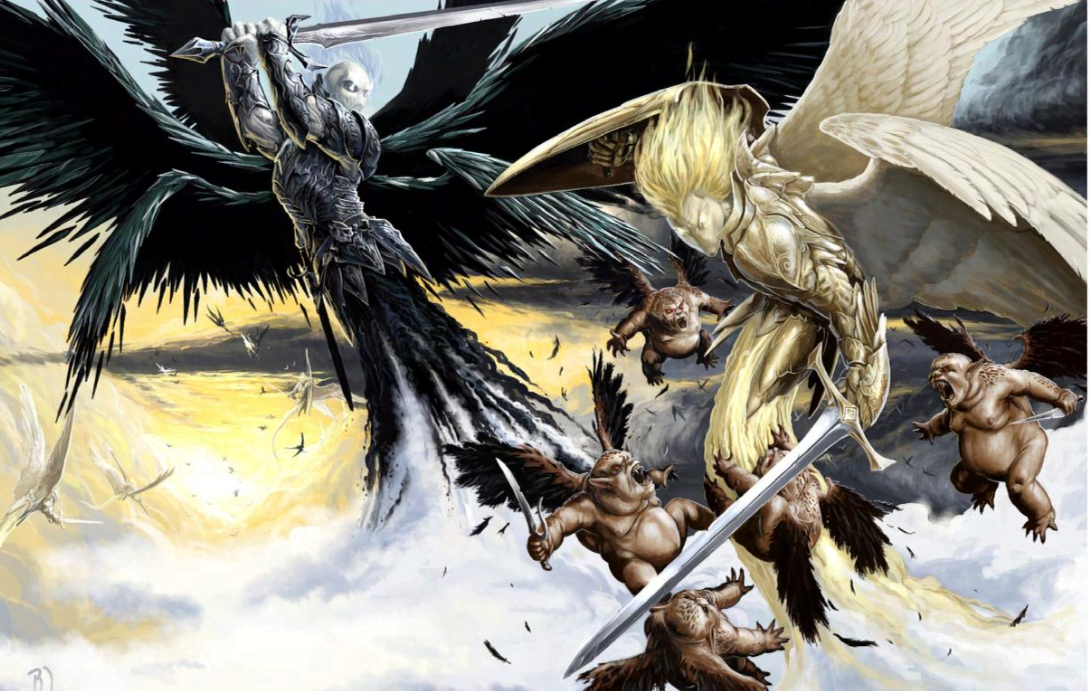One of the most frustrating things about how Fourth Edition treats its lore is that it assumes familiarity with the D&D mythology while at the same time it never tells you what’s actually canon anymore. For instance, “Codex of Betrayal: Beleth, the Witch’s Viscount” (Dragon #365, July 2008) assumes that everyone reading the article knows who individuals like Asmodeus, Levistus, Glasya, etc. are, that they are fully aware of the rankings of Hell’s dukes and how its layers/recent politics fit together… yet at the same time none of that has actually been addressed yet. In general, Fourth Edition assumes complete mastery of the world’s lore, which is always particularly irritating considering that even a person who has spent way too much time reading about said lore, i.e. me, is going to be frequently lost in this new edition.
After reading through this article, the first thing I did was look back through the Core trilogy and also Wizards Presents: Worlds and Monsters in search of a full accounting of Fourth Edition’s version of Hell. This simply does not exist, and the closest thing we have to it is the smattering of information tossed into the Devil entry in the Monster Manual. This spells out that Asmodeus is now a god, and clarifies that although it’s no longer a plane, rather it’s a dominion (what the fuck does this mean???), it still has nine… layers? Nine unclassified, uhh, slices that function like layers and are named the same as before with the same rulers as at the end of Third Edition. Levistus in particular gets some details in the pseudo-canonical companion book, but all of the information about Asmodeus’ war, some sort of curse on the devils, that nonsense? Yeah that’s not here, and knowledge that there was a previous archduke named Moloch, a night hag ruler named Malagarde, etc.? All of that is assumed knowledge in Dragon, but given that the entire universe has been retconned it would make more sense if none of what came before was canonical than the weird Fourth Editoin status quo where some is and some isn’t. Asmodeus is a god now, so why is everything else unchanged? It makes no sense, and is so goddamn frustrating when presented like this.
Assuming that you are weirdly familiar with the history of the game and its now-completely-changed-except-when-it-isn’t-but-we’re-not-going-to-tell-you-when-that’s-the-case mythology, “Beleth” is actually a pretty good article. The devil in question is essentially the lord of imps, taking interest in them rather than more powerful devils in order to avoid attention, and also because of his quantity over quality philosophy. Beleth himself is not an imp, he’s a unique duke (not archduke) of hell, whose natural form is seemingly that of a stereotypical devil but with long gray nails. Really, that’s the best I’ve got, as the article largely focuses on his history and not his description, but I did find it weird that I was never able to actually picture what he looks like.
The most important part of the article is Beleth’s history, since it stretches back to before Hell was even created. This allows Beleth to serve as a sort of key to Hell’s current structure, and through him and his machinations we learn that the history regarding Moloch, Malagarde, and Glasya is essentially the same as in last edition, though the Reckoning is never mentioned by name. It’s also unclear if Malagarde’s fate was quite as gruesome as before, as here Glasya simply “slew the Hag Countess in a brutal show of power,” which to me sounds like a normal affair and not a horrifying restructuring of the entire layer, but I’m guessing that they simply hadn’t decided on that point yet.
The article does kinda drone on a bit once it gets to present day Beleth and all of his little minions. That’s not surprising, as here it focuses on mechanics, but it also feels like Marnell is a little bit afraid to turn Beleth into a big enough player in Hell to actually cause some changes. This is an adversary who’s relevant, but will never depose one of the archdukes, and with that ends up feeling a bit like a filler entry. And while on the one hand, it’s great to learn about more denizens of Hell rather than more coverage of the same archdukes over and over again, that never really stopped the Demonomicon series from covering the bigwigs of the Abyss, and made for a more interesting series over all.
Despite my hatred for Fourth Edition, this first dragon article I’m covering for it is… pretty good. It’s worth reading, and though obviously few will be able to make use of the statistics, the lore is usable for any edition, and Beleth is a worthy addition to the game. Nothing here blew me away and made me excited for more in this series… which is fortunate because none of the new Fourth Edition Dragon series really took off and produced a multitude of articles. Regardless, “Beleth” felt like a fine continuation of the game’s history and tradition that tried harder at reconciling conflicting cosmologies than anything else thus far in the edition.. I still don’t really understand how Hell works as part of the Astral Sea, and if the layers are exactly the same as before but with a different name for these concepts, and all of that nonsense, but fortunately it’s all easy to ignore.




